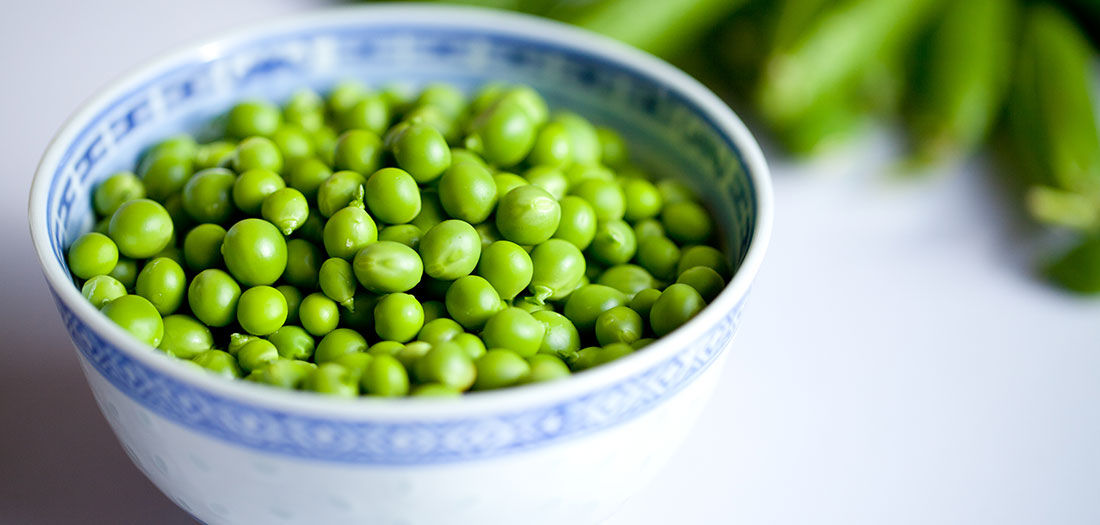When it comes to healthy eating, seasonal foods have so many benefits to offer. Not only are these five foods available at the peak of their ripeness, giving them maximum flavor and nutrition density, but they are also at their least expensive price.
Peas

Biting into these vibrant green beauties is sure to release a juicy and sweet pop of flavor. You can incorporate peas into a quick pasta or even as part of slow-cooked risotto. And, if the spring weather is still a bit chilly, whipping up a creamy pureed pea soup is both quick and easy.
- Did You Know? Peas are a wonderful plant-based source of protein. A 100-calorie serving has more protein than a hard-boiled egg or a tablespoon of peanut butter.
- Nutrition Facts: Peas are a good source of both vitamin C and vitamin K.
- Pair With: Mint, chives, tarragon and mushrooms
Asparagus

This springtime ingredient is extremely versatile and can be roasted, grilled, boiled or even sautéed. Moreover, asparagus works perfectly cooked in a breakfast quiche, used in a lunchtime Nicoise salad, or served alongside a grilled piece of salmon or steak, making it that much easier to get in the extra servings of veggies we all need.
- Did You Know? You can enhance the glowing green color of asparagus by blanching it. To do so, bring a pot of water to a boil and add in the asparagus for 1-2 minutes (depending on thickness). Next, remove the asparagus from the boiling water and immediately place inside an ice-cold bowl of water. The result is a gorgeous green seasonal food that is as pleasing to look at as it is to eat.
- Nutrition Facts: Asparagus is a good source of vitamin K and folate.
- Pair with: Lemon, almonds, parmesan and garlic
Leafy Greens

One of the first indications of spring is the tender unfurling of leafy greens like spinach, kale, collard greens, swiss chard, arugula, romaine and other lettuces. Regardless of form, all greens are considered healthy additions to a balanced diet.
- Did You Know? Most leafy greens taste the sweetest after a frost. Additionally, you can reduce the bitter flavor of greens by adding an acid like lemon juice or vinegar.
- Nutrition Facts: Leafy greens have some of the highest concentrations of vitamins—especially A, C, and K—as well as minerals like calcium, folic acid and iron.
- Pair With: Citrus, vinegar, nuts, and seeds
Radishes

The satisfying crispy crunch of radishes is complemented by the lovely mild pepper flavor they provide. While most people consume raw radishes, you can give them a quick pickle to turn up the flavor in tacos, or even roast them to bring out a caramelized sweetness.
- Did You Know? Radishes grow quickly and are ready to eat just 25-30 days after planting. If you want to test your green thumb, this is an ideal food to plant.
- Nutrition Facts: Radishes are loaded with both fiber and vitamin C.
- Pair With: Thyme, leeks, butter, and fish
Rhubarb

The delightful mix of sweet and sour make rhubarb a great seasonal food with which to experiment. While the most common way to use rhurbarb is to bake it into a sweet dessert, you can also pickle it for use in fresh salads.
- Did You Know? Rhubarb gets its pretty reddish pink color from a phytochemical called anthocyanin. In fact, the color of rhubarb can tell you whether the plant was grown outside or inside. Rhubarb grown outside will be a vibrant red, which also indicates more sweetness. Conversely, rhubarb grown indoors in a hothouse will have a color that tends to be pale red and a taste that is more tart.
- Nutrition Facts: Rhubarb is a good source of vitamins K and C, as well as the mineral calcium.
- Pair With: Strawberries, basil, honey and balsamic vinegar




 by
by 





 by
by